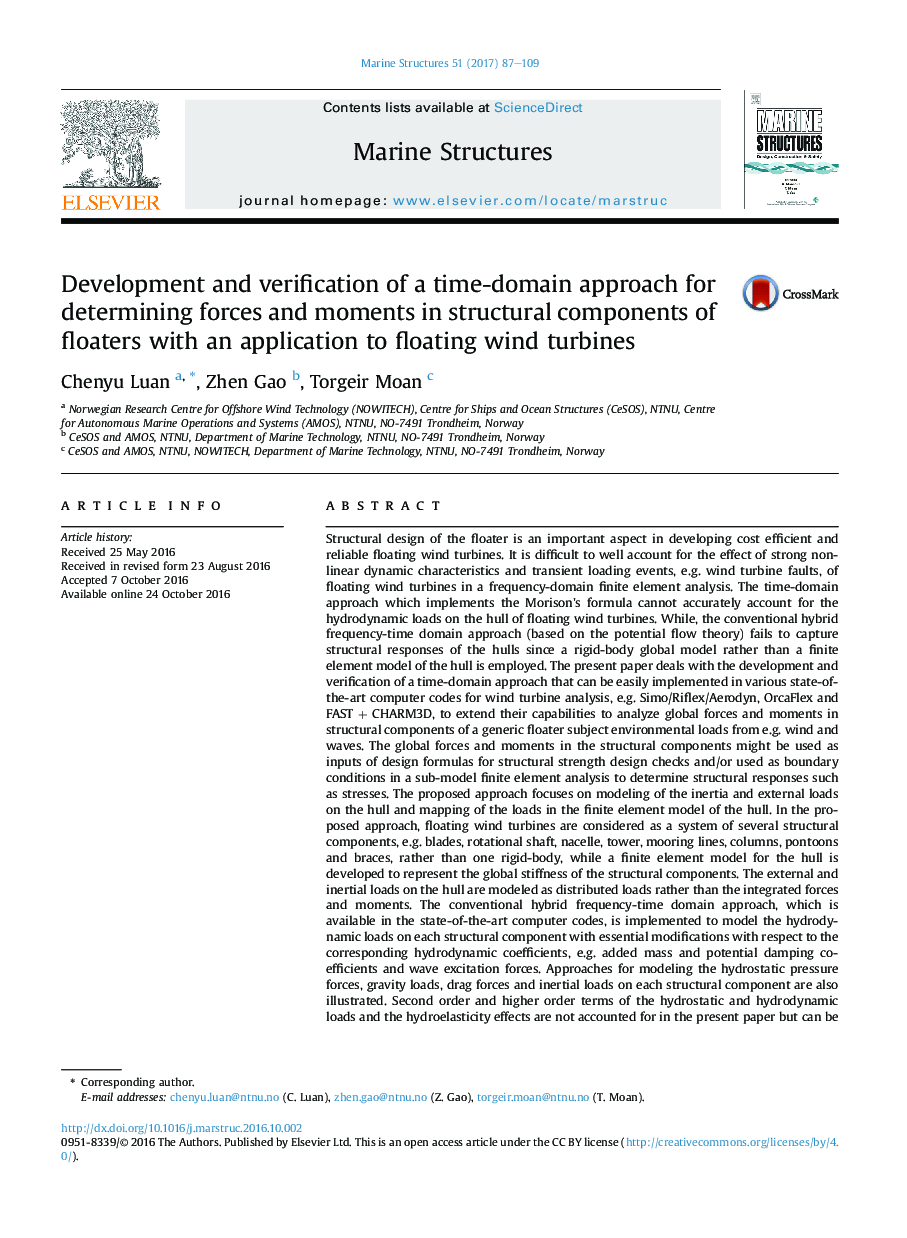| Article ID | Journal | Published Year | Pages | File Type |
|---|---|---|---|---|
| 4925083 | Marine Structures | 2017 | 23 Pages |
â¢Development and verification of a time-domain approach for determining global forces and moments in structural components of floating wind turbines.â¢The proposed approach is a generic approach and can be easily implemented in various state-of-the-art computer codes to extend their capabilities.â¢Good agreement in the reference values and simulation results.â¢The proposed approach can be implemented to investigate effects of each component of the environmental and inertia loads on structural responses of the hulls.
Structural design of the floater is an important aspect in developing cost efficient and reliable floating wind turbines. It is difficult to well account for the effect of strong non-linear dynamic characteristics and transient loading events, e.g. wind turbine faults, of floating wind turbines in a frequency-domain finite element analysis. The time-domain approach which implements the Morison's formula cannot accurately account for the hydrodynamic loads on the hull of floating wind turbines. While, the conventional hybrid frequency-time domain approach (based on the potential flow theory) fails to capture structural responses of the hulls since a rigid-body global model rather than a finite element model of the hull is employed. The present paper deals with the development and verification of a time-domain approach that can be easily implemented in various state-of-the-art computer codes for wind turbine analysis, e.g. Simo/Riflex/Aerodyn, OrcaFlex and FASTÂ +Â CHARM3D, to extend their capabilities to analyze global forces and moments in structural components of a generic floater subject environmental loads from e.g. wind and waves. The global forces and moments in the structural components might be used as inputs of design formulas for structural strength design checks and/or used as boundary conditions in a sub-model finite element analysis to determine structural responses such as stresses. The proposed approach focuses on modeling of the inertia and external loads on the hull and mapping of the loads in the finite element model of the hull. In the proposed approach, floating wind turbines are considered as a system of several structural components, e.g. blades, rotational shaft, nacelle, tower, mooring lines, columns, pontoons and braces, rather than one rigid-body, while a finite element model for the hull is developed to represent the global stiffness of the structural components. The external and inertial loads on the hull are modeled as distributed loads rather than the integrated forces and moments. The conventional hybrid frequency-time domain approach, which is available in the state-of-the-art computer codes, is implemented to model the hydrodynamic loads on each structural component with essential modifications with respect to the corresponding hydrodynamic coefficients, e.g. added mass and potential damping coefficients and wave excitation forces. Approaches for modeling the hydrostatic pressure forces, gravity loads, drag forces and inertial loads on each structural component are also illustrated. Second order and higher order terms of the hydrostatic and hydrodynamic loads and the hydroelasticity effects are not accounted for in the present paper but can be further included. So far, the proposed approach has been implemented in the computer code Simo/Riflex/Aerodyn to analyze global forces and moments in the hull of a semi-submersible wind turbine. Good agreement between the reference values and the simulation results has been observed and indicates that the developed time-domain numerical models are reliable. The simulation results show that the low-frequency aerodynamic loads and fluctuations of hydrostatic pressure forces on and gravity of the floating wind turbine are important contributions to the structural responses, in particular, in the low-frequency range.
